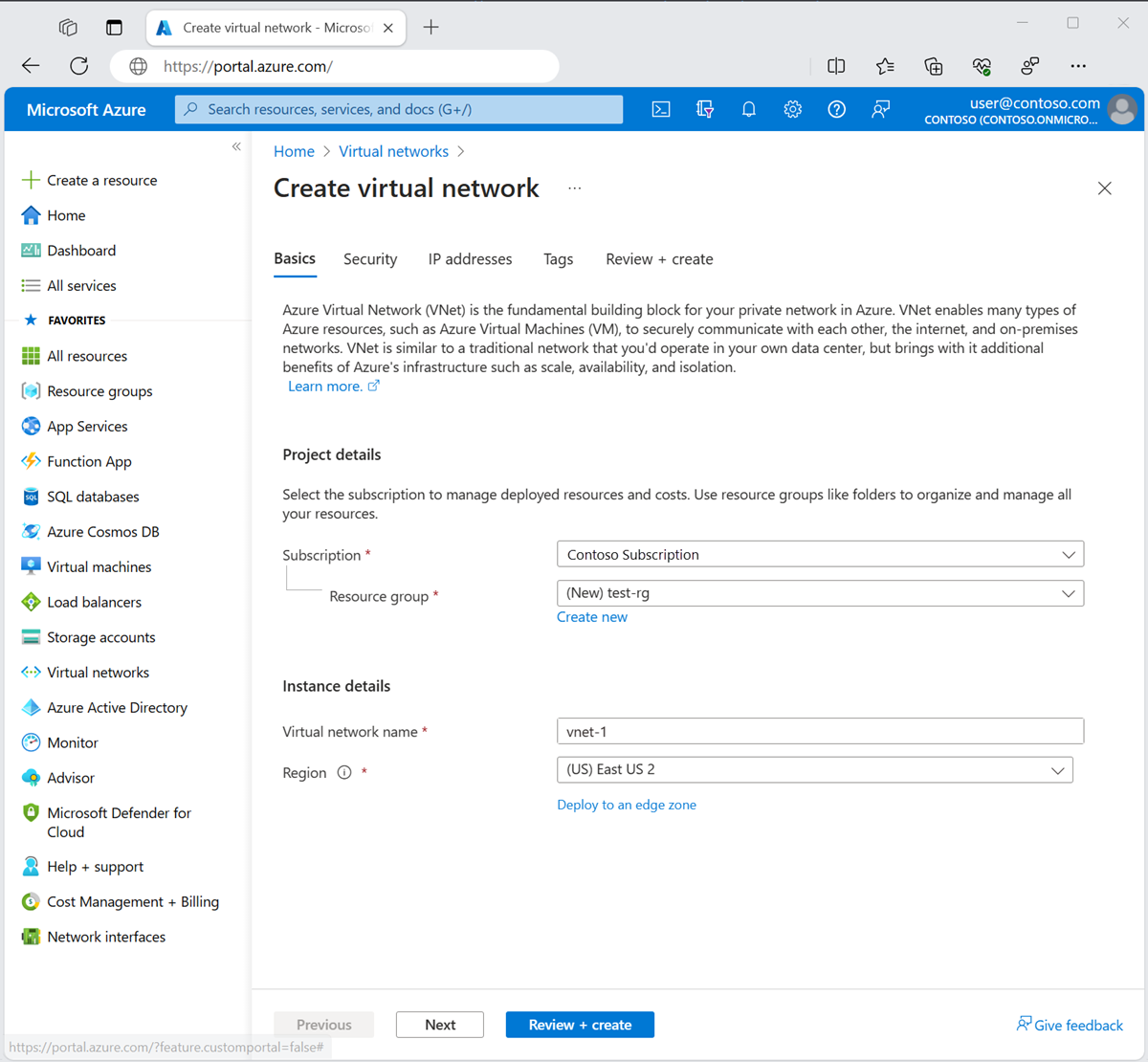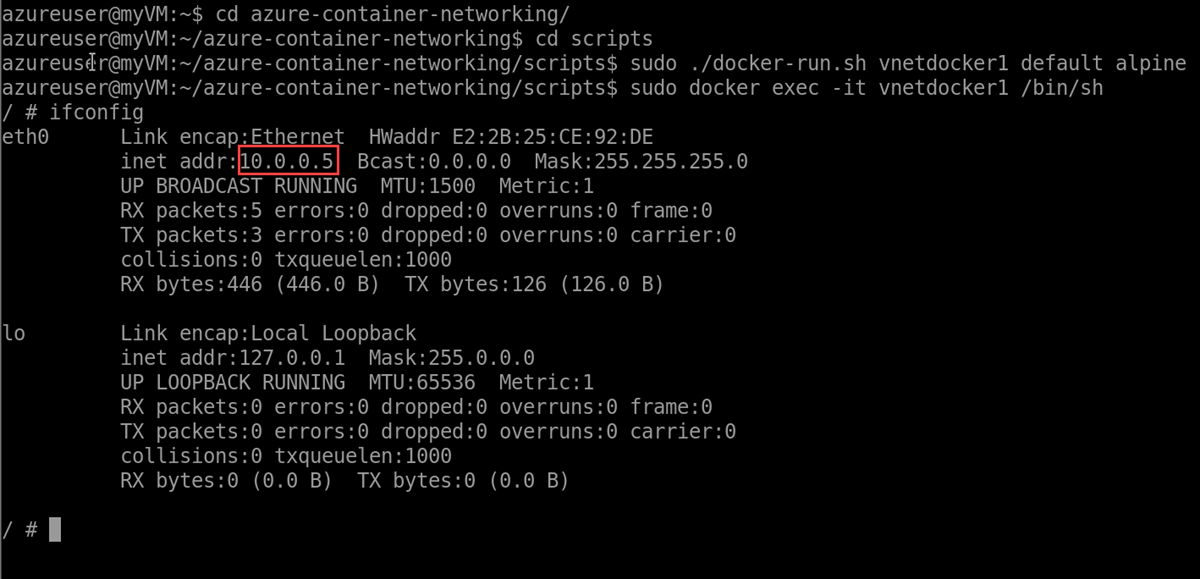Deploy container networking for a stand-alone Linux Docker host
The Azure CNI plugin enables per container/pod networking for stand-alone docker hosts and Kubernetes clusters. In this article, you learn how to install and configure the CNI plugin for a standalone Linux Docker host.
Prerequisites
- An Azure account with an active subscription. Create an account for free.
Create a virtual network and an Azure Bastion host
The following procedure creates a virtual network with a resource subnet, an Azure Bastion subnet, and a Bastion host:
In the portal, search for and select Virtual networks.
On the Virtual networks page, select + Create.
On the Basics tab of Create virtual network, enter, or select the following information:
Setting Value Project details Subscription Select your subscription. Resource group Select Create new.
Enter test-rg for the name.
Select OK.Instance details Name Enter vnet-1. Region Select East US 2. 
Select Next to proceed to the Security tab.
In the Azure Bastion section, select Enable Azure Bastion.
Bastion uses your browser to connect to VMs in your virtual network over Secure Shell (SSH) or Remote Desktop Protocol (RDP) by using their private IP addresses. The VMs don't need public IP addresses, client software, or special configuration. For more information, see What is Azure Bastion?.
In Azure Bastion, enter or select the following information:
Setting Value Azure Bastion host name Enter bastion. Azure Bastion public IP address Select Create a public IP address.
Enter public-ip-bastion in Name.
Select OK.
Select Next to proceed to the IP Addresses tab.
In the address space box in Subnets, select the default subnet.
In Edit subnet, enter or select the following information:
Setting Value Subnet purpose Leave the default of Default. Name Enter subnet-1. IPv4 IPv4 address range Leave the default of 10.0.0.0/16. Starting address Leave the default of 10.0.0.0. Size Leave the default of /24 (256 addresses). Select Save.
Select Review + create at the bottom of the window. When validation passes, select Create.
It can take a few minutes for the Bastion host to deploy. You can continue with the steps while the Bastion host is deploying.
Create test virtual machine
The following procedure creates a test virtual machine (VM) named vm-1 in the virtual network.
In the portal, search for and select Virtual machines.
In Virtual machines, select + Create, then Azure virtual machine.
On the Basics tab of Create a virtual machine, enter or select the following information:
Setting Value Project details Subscription Select your subscription. Resource group Select test-rg. Instance details Virtual machine name Enter vm-1. Region Select East US 2. Availability options Select No infrastructure redundancy required. Security type Leave the default of Standard. Image Select Ubuntu Server 22.04 LTS - x64 Gen2. VM architecture Leave the default of x64. Size Select a size. Administrator account Authentication type Select Password. Username Enter azureuser. Password Enter a password. Confirm password Reenter the password. Inbound port rules Public inbound ports Select None. Select the Networking tab at the top of the page.
Enter or select the following information in the Networking tab:
Setting Value Network interface Virtual network Select vnet-1. Subnet Select subnet-1 (10.0.0.0/24). Public IP Select None. NIC network security group Select Advanced. Configure network security group Select Create new.
Enter nsg-1 for the name.
Leave the rest at the defaults and select OK.Leave the rest of the settings at the defaults and select Review + create.
Review the settings and select Create.
Note
Virtual machines in a virtual network with a bastion host don't need public IP addresses. Bastion provides the public IP, and the VMs use private IPs to communicate within the network. You can remove the public IPs from any VMs in bastion hosted virtual networks. For more information, see Dissociate a public IP address from an Azure VM.
Note
Azure provides a default outbound access IP for VMs that either aren't assigned a public IP address or are in the backend pool of an internal basic Azure load balancer. The default outbound access IP mechanism provides an outbound IP address that isn't configurable.
The default outbound access IP is disabled when one of the following events happens:
- A public IP address is assigned to the VM.
- The VM is placed in the backend pool of a standard load balancer, with or without outbound rules.
- An Azure NAT Gateway resource is assigned to the subnet of the VM.
VMs that you create by using virtual machine scale sets in flexible orchestration mode don't have default outbound access.
For more information about outbound connections in Azure, see Default outbound access in Azure and Use Source Network Address Translation (SNAT) for outbound connections.
Add IP configuration
The Azure CNI plugin allocates IP addresses to containers based on a pool of IP addresses you create on the virtual network interface of the virtual machine. For every container on the host, an IP configuration must exist on the virtual network interface. If the number of containers on the server outnumber the IP configurations on the virtual network interface, the container starts but doesn't have an IP address.
In this section, you add an IP configuration to the virtual network interface of the virtual machine you created previously.
In the search box at the top of the portal, enter Virtual machine. Select Virtual machines in the search results.
Select vm-1.
In Settings, select Networking.
Select the name of the network interface next to Network Interface:. The network interface is named vm-1 with a random number.
In Settings of the network interface, select IP configurations.
in IP configurations, select ipconfig1 in Name.
In the ipconfig1 settings, change the assignment of the private IP address from Dynamic to Static.
Select Save.
Return to IP configurations.
Select + Add.
Enter or select the following information for Add IP configuration:
Setting Value Name Enter ipconfig-2. Private IP address settings Allocation Select Static. IP address Enter 10.0.0.5. Select OK.
Verify ipconfig-2 has been added as a secondary IP configuration.
Repeat the previous steps to add as many configurations as containers you wish to deploy on the container host.
Install Docker
The Docker container engine must be installed and configured on the virtual machine you created previously.
Sign-in to the virtual machine you created previously with the Azure Bastion host you deployed with the virtual network.
In the search box at the top of the portal, enter Virtual machine. Select Virtual machines in the search results.
Select vm-1.
In the Overview of vm-1, select Connect then Bastion.
Enter the username and password you created when you deployed the virtual machine in the previous steps.
Select Connect.
For install instructions for Docker on an Ubuntu container host, see Install Docker Engine on Ubuntu.
After Docker is installed on the virtual machine, follow the instructions for the Linux post install. For instructions on the Linux post install, see Docker Engine post-installation steps.
After Docker is installed on your virtual machine, continue with the steps in this article.
Install CNI plugin and create a test container
The Azure CNI plugin is maintained as a GitHub project and is available for download from the project's GitHub page. For this article, you use git within the virtual machine to clone the repository for the plugin and then install and configure the plugin.
For more information about the Azure CNI plugin, see Microsoft Azure Container Networking.
In the search box at the top of the portal, enter Virtual machine. Select Virtual machines in the search results.
Select vm-1.
In the Overview of vm-1, select Connect then Bastion.
Enter the username and password you created when you deployed the virtual machine in the previous steps.
Select Connect.
The application jq is required for the install script for the CNI plugin, use the following example to install the application:
sudo apt-get update sudo apt-get install jqNext, you clone the repository for the CNI plugin. Use the following example to clone the repository:
git clone https://github.com/Azure/azure-container-networking.gitConfigure permissions and install the CNI plugin. The install script command requires a version number for the CNI plugin. At the time of the writing of this article, the newest version is
v1.4.39. To obtain the latest version number of the plugin or previous versions, see Releases.cd ./azure-container-networking/scripts chmod u+x install-cni-plugin.sh sudo ./install-cni-plugin.sh v1.4.39 chmod u+x docker-run.shTo start a container with the CNI plugin, you must use a special script that comes with the plugin to create and start the container. The following example creates an Alpine container with the CNI plugin script:
sudo ./docker-run.sh vnetdocker1 default alpineTo verify that the container received the IP address you previously configured, connect to the container and view the IP:
sudo docker exec -it vnetdocker1 /bin/shUse the
ifconfigcommand in the following example to verify the IP address was assigned to the container:ifconfig
When you finish using the resources that you created, you can delete the resource group and all its resources.
In the Azure portal, search for and select Resource groups.
On the Resource groups page, select the test-rg resource group.
On the test-rg page, select Delete resource group.
Enter test-rg in Enter resource group name to confirm deletion, and then select Delete.
Next steps
In this article, you learned how to install the Azure CNI plugin and create a test container.
For more information about Azure container networking and Azure Kubernetes service, see:
